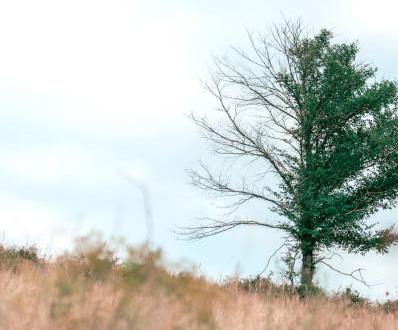PAGE 15-31
INDIGENOUS PEOPLE’S DAY
Read stories relating to the

PAGE 15-31
Read stories relating to the
LAÍSA CONDÉ newsroom@merrittherald.com
A major fire broke out at the Comfort Inn & Suites in Merritt early Friday morning, causing extensive damage to the building. On June 13, at 1:30 a.m., both Merritt RCMP and the Merritt Fire Rescue Department crews responded to a structure fire at the hotel located on Crawford Avenue.
According to the RCMP, all hotel occupants were safely evacuated, with no injuries reported.
“A significant section of the building was engulfed, resulting in extensive damage,” Cpl. James Grandy, Southeast District RCMP spokesperson, said in a press release.
“Fire investigators and Merritt RCMP officers remain on scene today gathering evidence and determining the cause of the blaze.”
Police are asking for anyone with information to contact the Merritt RCMP at 250-378-4262 or Crime Stoppers at 1-800222-TIPS (8477).

PAGE 32-35
Relive

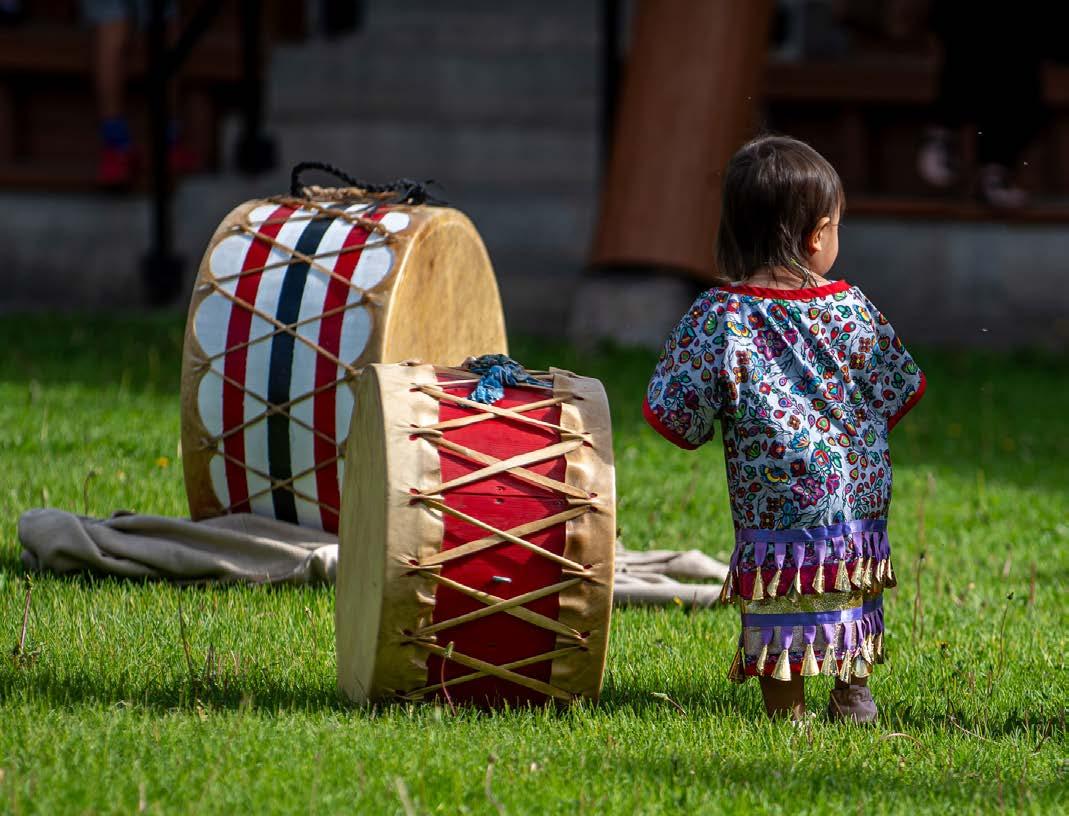













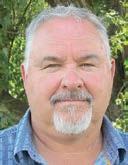




























TY LIM reporter@merrittherald.com
Families on the fringes of the school district will not have to worry about paying for their kids to get into school each day.
Nicola-Similkameen School District 58 has shut down any idea of charging families - either in rural areas or within the five km walking distance of their catchment school - to ride district school buses.
“The board has no intention of charging our rural students,” said SD58 board chair Gordon Swan.
For the past few months, as budget has been the main concern of the school district, Swan has swatted away any suggestion of SD58 charging rural families
for bus rides in order to provide a revenue stream to help fund the existing bus routes.
The blowback and suggestions to charge for bussing, came from parents, Swan said.
During budget cuts, the district reduced the number of buses within Merritt, specifically to Collettville Elementary, in which service was reduced from six buses to one.
SD58 Superintendent Courtenay Lawrance now claims the district doesn’t have enough space to fulfill the bussing needs of every student, especially if further cuts are enforced.
Despite this, Swan confirmed with the rest of the school board that they have no one on the board has any intention of
making kids pay for transportation.
Swan further said that for the service area and other transportation options available, bussing in SD58 is severely underfunded.
According to Lawrance, the district receives around $800,000 per year to apply to transportation costs.
Swan said even though transporataton funding is at the highest it’s ever been, that number still has not kept up with inflation.
Swan and Lawrance said they are working with other school districts to try and get transportation to be seen as a core service, especially in rural districts.. Elsewhere, SD58 is still looking to start the procedure to explore the possibility of a school closure.



LAÍSA CONDÉ
newsroom@merrittherald.com
The Nicola-Similkameen School District (SD58) has announced in a press release its new secretary treasurer and chief financial officer.
Mark Friesen is joining the school district and brings an extensive experience in financial leadership, organizational, improvement, and values-driven service within the education and not-for-profit sectors. Friesen served as assistant secretary treasurer in the Chilliwack School District. In that role, he led major systems improvements, modernized operational processes, and promoted a culture of empowerment and service.
His leadership also helped staff connect their work to the broader success of schools and students across the district.

Beyond his work in B.C., Friesen’s commitment to meaningful service has taken him abroad. He spent several years in Uganda, where he established financial and administrative systems for orphanage schools.
Upon returning to Canada, he served as chief financial officer for Immigrant Services Calgary, a government-funded non-profit supporting a highly diverse community.
“Mark brings not only strong technical and leadership skills, but also relational and community-minded approach,” said a statement from the school district.
“He has built strong partnerships with school and Indigenous leaders throughout his career and is deeply committed to supporting the learning and success of all students through sound financial stewardship.”




Dollarama on Forksdale Ave. that was robbed on May 28.
TY
Dollarama on Forksdale Avenue was robbed at knifepoint late last month.
The robbery was announced to the public earlier last week through the City of Merritt’s monthly RCMP Updates, presented to city council at the beginning of each month.
The Dollarama was robbed at around 4:30 p.m. by a man around six-feet tall wearing a green shirt, grey sweatpants and a mask.
TY LIM reporter@merrittherald.com
Merritt is getting a little safer as the city will be looking into buying defibrillators for all city-owned facilities.
In a motion called forth by Merritt City Coun. Wendy Charney, she recommended that the city look into having automated external defibrillators (AEDs) on all of their properties.
“I think it’s a really important that a life-saving measure is within reach of anybody that is in a city-owned facility,” she said.
AEDs could cost over $2,000 per unit, something the city and Charney are aware of. Despite the cost, Charney said it is important Merritt sets a safety standard by having those units readily available. The decision was supported by council during a June 10 meeting.


RCMP say the suspect ran from the scene of the crime on foot, and that the suspect is still unidentified.
Merritt officers did however find evidence near the crime scene which they are using to further investigation.
Any members of the public with potential information on the robbery are encouraged to call the Merritt RCMP detachment at 250-378-4262.
The call was one of 610 incidents Merritt RCMP have responded to in May.




TY LIM reporter@merrittherald.com
A Gozda family dream eight years in the making has finally been completed. Friday, June 13 was the official opening of the Kamloops Ronald McDonald Family Room at the Royal Inland Hospital. The family room provides a space over 1,000 square feet for families from out-of-town to be taken care of, with a bedroom, a kitchen, groceries and a shower.
“They can come and have a meal, take a break, maybe do some homework with their other children, catch their breath. And there is a bedroom for a family to sleep,” said Brandy Gozda-Sekhon, owner of McDonald’s locations in Merritt and Kamloops and who is helping to carry out her father’s dream of opening a family room in Kamloops.
“This started back in 2017. My dad was on the board for the hospital, and him and health minister Terry Lake at the time, they saw the need,” Gozda-Sekhon said. “They saw that Kamloops needed this.” Gozdha-Sekhon and her family donated around $140,000 to the family room, which was furnished by her husband Sonny Sekhon, owner of Merritt City Furniture. The opening was attended by other donors, a family who used a Ronald

McDonald House before and many others.
“It’s finally come to fruition,” said Gozdha-Sekhon. “I’ve cried probably 30 times today with joy and happiness and pride that this is happening.”
As a resident of the Interior and a mother to five children, Gozdh-Sekhon felt the opening of the family room deeply.
She said 27 per cent of families that stay in the Ronald McDonald House are from the Interior.
“Families might have someone close by to be able to stay with here, but this is for the families that come from, like Merritt, Quilchena, those types of places,” she said.
“I could not even fathom if my child was sick and in the hospital and needed any type of medical attention and I couldn’t be with them at every waking moment. And the Ronald McDonald family room in Kamloops is going to help eliminate separation between parents and children.”
Gozdha-Sekhon thanks the people of Merritt for their support on McHappy Day, which raised around $90,000 between Merritt and Kamloops.
She said if anyone wvants to tour the family room or make a donation, they can contact her by social media or through her restaurants in Merritt and Kamloops.

Wea re look ingfor af ul lt im ereliabl ea nd orga ni zedF ront Sto re Ma na ge r/
Re ce iver to jo in ou rteam. In th is ro le,you’l lmanag ethe da il yope rati on sof thef ront store,over seei nvento ry cont ro l, andp rovi de except io na lcus to me r ser vi ce to ou rval uedcli ents.
KeyResponsibilities:
•Superviseandmanagetheday-to-dayoperationsofthefrontstore
•Receive,verify,andorganizeallincominginventoryshipments
•Maintainaccuratestocklevelsandensure propermerchandising
•Train,supervise,andschedulefrontstore staff
•Provideexceptionalcustomerserviceandresolveclientconcerns
•Collaboratewiththepharmacyteamtoensurea smoothoperation
Requirements:
•Previousretailorpharmacyfrontstoremanagementexperiencepreferred
•Abilitytoliftandmanagestock(upto40lbs)
•Strongleadership,organizational,andcommunicationskills
•FamiliaritywithPOSsystemsandinventorymanagementsoftware
•Dependable,detail-oriented,andcustomer-focused
WhatWeOffer:
•Competitivewagebasedonexperience
•Staff discountsandbenefitspackage
•Friendly,supportiveworkenvironment
•Opportunitiesforgrowthandcareeradvancement
TOAPPLY Pleasesendyour resumeandcoverlettertoblacksrx@telus. netorapplyinpersonatBlack’sPharmacy,2037Quilchena Ave,Merritt,BC Forinquiries,pleasecall:250-378-2155

NARAYAN MITRA You Gotta Have Faith
One of the great hymns of Christian faith, Faith of Our Fathers, celebrates not only faith in God, but also the mood of piety within the family.
A part of the hymn’s lyric goes like this: Faith of our fathers living still/In spite of dungeon, fire and sword/How sweet would be their children’s fate/If they, like them, could die for Thee.
It is a picture of the deep relationship between regard for parents and regard for the faith which the parents have given us. It’s indeed sweet to have a faith for which we could die.
Sadly, as author C.S. Lewis has said, those who are willing to die for their faith become, at times, easily willing to kill for it.
When we try to understand what the Holy Bible has to say about faith in the family, we should be careful to understand it in the biblical sense and not in the sense of uncritical adoration of parents or of their faith.
There is a trend of thought today that says submission to parents is part of an authoritarian age which has passed away. Certainly the most conservatives of us have no desire to return to ancient Germanic or Roman concept of fatherhood.
In ancient Rome, the father had the right, without incurring any legal
penalties whatsoever, to kill his children if they displeased him. The right of life and death over the children was held by dads. Fortunately, this is not a Christian concept
As a matter of fact, such patriarchal authoritarianism must never be confused with piety. Let us not undermine the biblical teaching with unbiblical reactions.
A reaction to excessive authoritarianism is being increasingly found in the current attack upon the family.
The renowned sociologist and anthropologist Margaret Mead tells us that we must totally reorganize our society because children today know more than their parents do.
Their education is much better and knowledge is changing so rapidly, says Mead, that it is ridiculous for parents to assume that they have the right to tell their children what to do.
It is interesting that the Bible itself does not subscribe to a totally authoritarian picture of the family relationships.
Jesus went to a temple at the age of 12 and apparently forgot about his waiting parents.
They left for home and, on the way, they were missing him. A search for young Jesus started.
When his mother finally found him back in the temple, disputing with some scholars, she scolded him. At this, his reply was: “I must be about my Father’s business.”
Hardly sounds like total submission to parents!
Saint Paul could, in one sense, never have sung, “Faith of our fathers…”
He left the faith of his father and repudiated it in one sense. He was not one


who could to a belief just because his parents did.
One of the Ten Commandments in the Scriptures is: “Honour your father and your mother that your days may be prolonged in the land which the Lord your God gives you.”
Sometimes, in order to obey God, we may have to go against our parents’ wishes. But there is no time when we may dishonour them.
In the case of unworthy parents, there is the honour due them as persons, as those who have sacrificed something for us even though we might have occasionally suffered wrong at their hands.
It is true that Paul repudiated the Jewish orthodoxy of his parents for the newer Christian faith. But, in defending himself before Governor Felix, he said: “I do serve the God of our fathers” (Acts 24:14). His conversion to a different faith was not totally a repudiation but a fulfillment.
It’s as if he was saying, “I’m really going back to the true religion of the fathers.”
Many of the secular attacks on the family today are without justification. Underlying so much of the talk we hear is the idea that, because they are young, youth know more and achieve more.
It is certainly true that many great things have been accomplished by young people both today and yesterdays.
But let us not forget that Moses was an octogenarian when he led the Israelites out of Egypt.
Let us forget the business of old and young and together walk the path of filial piety. Respect is due to every human


being.
The young people’s incapacity to accept this fact in regard to their parents will destroy their capacity to relate to anybody else. They cannot have a lousy relationship with their parents and have a good relationship with everyone else.
Even the worst parent is worthy of respect as a person.
The biblical standard of honouring and obeying parents does not mean that children are without recourse.
The church does not endorse carte blanche everything parents do or say. We do not live under Roman law. The laws of the land say that parents are denied the right to do certain things to their children.
Let us remember, above all, the example of Jesus, because “he learned obedience from the things which he suffered” (Hebrews 5:8).
When the Father asked him to die, he said: “Father save me from this hour.” There was not any voice, but he knew there was an answer.
Jesus replied: “Not my will but Yours be done.”
In Psalm 103:10 King David said: “He (God) has not dealt with us according to our sins, nor rewarded us according to our iniquities.”
If we really understand a right relationship with God, we will rightly relate to both our parents and our children.

Editor,
We are pleased Merritt has decided to revitalize the downtown core.
We, the people have ben forced to watch in horror the drug abuse/ overdoses and the continual presence of ambulances and police in and around the Post Office and back alleys.
Let’s hope the City and Council members (and Townspeople) will continue to find ways to make the changes needed to end these illegal activities.
As an aside, how about changing the name of Spirit Square!
Something like Merritt Central.
Also possibly putting a screen up, posting upcoming events, like the rodeo or hockey games (even showing these events on the big screen) or old movies like Clint Eastwood, John Wayne, music. So many ideas.
Merritt the old can become Merritt the new, so we can all enjoy this lovely little city.
– Chloe Gravelle, Merritt
Editor,
Canada’s 2025 Presidency of the G7 countries is not a coincidence, and it is a pivotal moment in history as the summit marks the 50th anniversary.
Global issues such as
tuberculosis, malaria, and access to quality education require immediate attention and action because the world’s journey toward greater equity and health is shaky and inconsistent.
The G7 Canadian Presidency has already set the right tone for the summit based on its 3-point agenda, namely: Protecting our communities and the world, Building energy security and accelerating the digital transition and Securing the partnerships of the future.
Now is the time to set aside individual country agendas, tariff wars and the like to take decisive action on serious global issues, especially around conflict.
Access to education remains the most potent tool in the long term to end conflict and insecurity globally because, according to United Nations Educational, Scientific and Cultural Organization (UNESCO), since wars begin in the minds of men, it is in the minds of men that the defences of peace must be constructed.
According to UNESCO’s Global Education Monitoring Report released October 2024, 251 million children and youth are still out of school showing signs that goal 4 of the Sustainable Development Goals (SDGs) to ensure inclusive and equitable quality education and promote lifelong learning opportunities for all by 2030 is shaky nearly ten years after it was adopted by world leaders.
With just five years to the target year, Canada has the chance to influence how the world’s advanced economies push forward innovative financing towards education in low-income countries.
Seven years ago, Canada made
history by leading the G7 to deliver game-changing investment in education for women and girls in crisis and conflict settings through the Charlevoix Declaration.
As Canada prepares to host the G7 once again, we have a powerful opportunity to build on that 2018 legacy that marked a turning point in global leadership on education by leveraging over $3.8 billion.
It helped millions of girls and young women access the education they need to thrive, even in the most challenging contexts and crises.
With the severance of collaboration by the US in the international community, now is the time to rally around, mend fences and ensure a vacuum is not created.
The G7 summit holding in Kananaskis, Alberta, from June 15 to 17 will be the first major opportunity for the leaders to converge at the same time since major elections and transitions happened in the last 12 months in five of the seven countries namely: the UK, Japan, US, Canada and Germany.
It therefore provides an avenue to make a strong statement about global cohesion and international development, irrespective of differences and in-country agendas. With more children out of school due to conflict than at any point since World War II, Canada must lead again with a bold new commitment. Education is about more than the curriculum – it fosters peace, security, and gender equality.
– Adeolu
Adekola, Saskatoon
JUNE 23, 2016

Billy Miner, who had friends in many B.C. townsm including those in the Nicola Valley, was known as a “first class bandit.” He was born in Kentucky and raised in Texas. He started his escapades robbing stagecoaches when he was just a teenager. It was Miner who first used the phrase, “hands up,” and his first stick-up netted him $75,000. When stage coaches became obsolete, Bill turned his attention to trains.
But he didn’t always get away scot-free. During his lifetime he spent a total of 29 years and seven months behind bars, was released twice and escaped five times. He was called the “master criminal of the American West.”
JUNE 23, 2016
The dirt was flyin’ at the old Campground C location on the former Merritt Mountain Music Festival site as the Northwest Mud Racing Association held its annual two-day event in the Nicola Valley on the weekend.
This year’s races were scheduled two weeks earlier in the past, in an effort to avoid the 40-degree Celsius temperatures in 2015 that took their toll on drivers, vehicles and spectators.







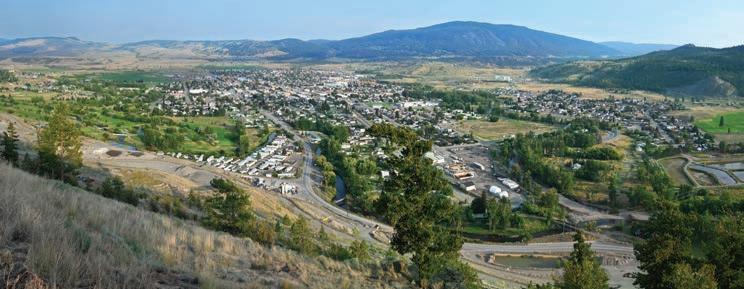







WOLFGANG DEPNER
The Canadian Press
British Columbia Conservative Leader John Rustad is accusing a group of legislators who split from the party of blackmailing its members and staff in a bid to take over and divide the Opposition.
Rustad has confirmed the authenticity of a letter obtained by The Canadian Press in which he tells the Conservative caucus that their former colleagues and staff are threatening to release “blackmail materials,” including secretly recorded phone conversations and text messages.
“We will not allow ourselves to be lowered by manipulative, dishonest, and malicious actions of people who see fit to, potentially criminally, blackmail others,” Rustad tells the Conservative caucus in the letter. “This is sociopathic behaviour.”
He said in an interview on Monday that the letter was authentic and the party was considering whether to call in the RCMP.
The letter says the targets are being blackmailed to get them to take jobs or contracts with the former Conservatives, or to “do or say certain things” if they want to prevent the materials being leaked.
“From what I have been told, the threat is framed as something like: we will pay you handsomely to join with us, we will damage you if you refuse,” Rustad says in the letter.
Rustad doesn’t name the former Conservatives, but Dallas Brodie, who was ejected from the caucus in March, said in a statement on Monday that the letter consists of “wild lies” and “baseless, false, and defamatory” accusations about her new One BC party, launched with fellow former Conservative Tara Armstrong last week.
She also said Rustad and his team “rigged” the Conservatives’ March annual general meeting that endorsed his “Team Rustad” slate of executive candidates, allegedly stacking the meeting with South Asian supporters paid “to vote the way Mr. Rustad wanted.”
Rustad’s letter denied any wrongdoing at the meeting.
He said in the letter that some in the party were surprised at a large number of South Asian party members at the AGM, and that “individuals” had paid for the whole group’s transport to the Nanaimo meeting.
He said he understood why “people who have not participated in organized political parties before may be surprised by this phenomenon.”
But he said “group-based political organizing occurs quite often in politics and is not unique to the South Asian community.”
“I have been advised by our legal council and experts, who were present to scrutinize the voting process that our AGM was 100 per cent in line with this party’s 2024-25 constitution,” he said.
Rustad said in the interview the he could not offer any details about what kinds of jobs were allegedly being offered to the targeted Conservatives. “I wasn’t party to those conversations, so I would be saying it third-hand,” he said.
The letter says one unnamed staffer with the former Conservatives called “multiple individuals in order to explicitly blackmail them.”
Rustad said in the letter that the former colleagues were “trying to sink our party, sour our caucus, and break apart the powerful movement” that Conservatives have built.
Asked about his characterization of their alleged behaviour as sociopathic, Rustad said “certainly, it is not normal.”
Brodie was thrown out of the party over remarks about residential schools, prompting Armstrong and Jordan Kealy to quit the party in sympathy.
Armstrong said she won’t comment beyond the statement Brodie issued, while Kealy, who still sits as an Independent, said he had no involvement in the alleged blackmail.
Brodie’s statement said that there was a “mountain of evidence” demonstrating the rigging of the AGM, “including photographs, emails, audio recordings, detailed written statements and public statements and interviews from various AGM attendees” and “a personal confession by a senior Rustad staff member.”
Brodie, Armstrong and Kealy first came forward with claims
about vote-rigging on May 28.
Armstrong said at the time that an unnamed senior member of Rustad’s team told her the party paid about $100,000, using that member’s personal credit card, to transport more than 100 South Asian men to Nanaimo to “rig the election” in favour of Rustad. She did not name the person or offer any other evidence.
Rustad’s letter suggested there was nothing unusual about Conservative riding association funds being used to sponsor delegates to attend the AGM.
“Hundreds of people, the vast majority of whom were Caucasian (not that it should matter), were ultimately sponsored by our caucus members via funds from your Riding Associations — at your specific direction as MLAs,” he told the caucus.

areheretohelpwith








THE CANADIAN PRESS
The “Canada Strong Pass’ takes effect Friday, offering free admission to national parks, national historic sites and marine conservation areas maintained by Parks Canada.
The “Canada Strong Pass’ takes effect Friday, offering free admission to national parks, national historic sites and marine conservation areas maintained by Parks Canada.
The pass also includes a 25 per cent discount on camping fees.
The pass also includes a 25 per cent discount on camping fees.
The program, which runs until Sept. 2, follows up on a Liberal campaign promise to promote Canadian tourism in response to the United States’ tariff war.
The program, which runs until Sept. 2, follows up on a Liberal campaign promise to promote Canadian tourism in response to the United States’ tariff war.
The pass also covers free national museum admission for children 17 and under, and a 50 per cent discount for 18- to 24 year-olds.
The pass also covers free national museum admission for children 17 and under, and a 50 per cent discount for 18- to 24 year-olds.
Via Rail is also offering free fares for children 17 and under if they are accompanied by an adult, and a 25 per cent discount for travellers 18 to 24 years old.
Via Rail is also offering free fares for children 17 and under if they are accompanied by an adult, and a 25 per cent discount for travellers 18 to 24 years old.
There is no physical “Canada Strong Pass” or registration required — visitors can just show up at participating locations.
There is no physical “Canada Strong Pass” or registration required — visitors can just show up at participating locations.




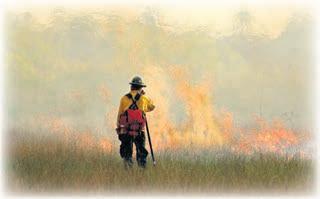


LAÍSA CONDÉ newsroom@merrittherald.com
Merrittonians who are looking to pitch in for a good cause will have the opportunity to eat some good food this summer.
Merrittonians who are looking to pitch in for a good cause will have the opportunity to eat some good food this summer.
The Royal Canadian Legion Branch #96 will be hosting a fundraiser for the second annual Ride for Vision and Valour program.
The Royal Canadian Legion Branch #96 will be hosting a fundraiser for the second annual Ride for Vision and Valour program.
Those who wish to support the cause can join the riders, guests and members at the Royal Canadian Legion Branch #96 for dinner on July 3, at 5 p.m.
Those who wish to support the cause can join the riders, guests and members at the Royal Canadian Legion Branch #96 for dinner on July 3, at 5 p.m.
The Ride for Vision and Valour is a four-day motorcycle journey which aims to raise funds for the Military Police Fund for Blind Children, supporting the visually impaired youth across Canada.
The Ride for Vision and Valour is a four-day motorcycle journey which aims to raise funds for the Military Police Fund for Blind Children, supporting the visually impaired youth across Canada.











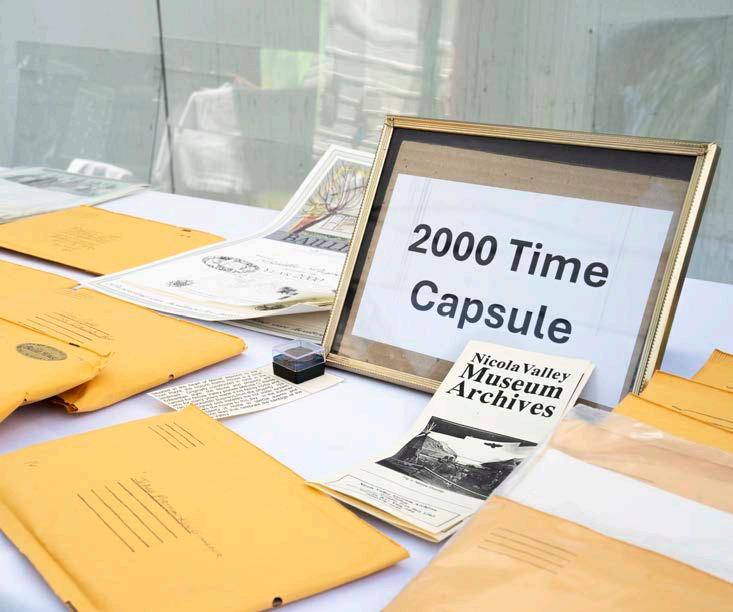
Parcels from Merritt’s 2000 time capsule opened on June 14, 2025.
TY LIM reporter@merrittherald.com
Merritt has been taken back to the past, as a time capsule a quarter of a century old has been dug up on Saturday, June 14. “(The importance of a time capsule) is to see how it was back then,” said Angie Allgrove, who worked on organizing the time capsule unveiling. “The difference between now and then is 25 years, it’s a big spread.”
Dozens of parcels were opened on the ground of the Baillie House as volunteers took to unearthing a piece of the past. It was previously said that there were 40 submissions to the time capsule back in 2000, though at the opening, only a handful of the original submitters came to
pick up their parcel.
The unclaimed parcels were opened for the public to see. Most of the items were letters to family members or pieces of Merritt, such as issues of the Merritt Herald or Merritt Morning Market from 2000.
There were also plenty of references to the theorized Y2K event.
The day also provided an opportunity for Merritt citizens to start a new time capsule.
Karen Treis, a Merritt resident since 1969 placed a coin featuring the likeness of the new English King Charles III in the time capsule, seeing it a fitting symbol of 2025.









COLIN MOLNAR
Contributor
With abundant sun hours, a lengthy air conditioning season, and a population of sun-loving locals (including a First Nations community that’s already publicly embraced the technology in a major way), Merritt is poised to utilize solar at a scale unmatched in the province.
Picture this: You’re driving the Coquihalla, cresting the summit and beginning your descent into the Nicola Valley. The mountains stretch wide, sagebrush dips into coulees, and just beyond the bend, there’s our charming city of Merritt. But something’s different. From this vantage point, rooftops are catching the light not just with shingles, but with rows of gleaming solar panels. It’s not a fantasy. In fact, Merritt is already starting to sparkle in the daylight. The impact of the global transition away from fossil fuels and towards more renewable forms of energy will not bypass our province. Despite relatively low electricity costs compared to many of our North American neighbours (see Alberta which has experienced a tripling of its electricity bills over the last decade), even our great backbone of hydroelectric infrastructure requires support. And prices are rising here, too — last year our provincial utility hiked prices 6.4 per cent, and this year and next they’ll raise them again nearly as much or more, according to former BC Utilities Commision boss, Richard Mason. At these rates, the next 20 years are slated to look a lot financially different than the last.
Solar is actually an old technology first discovered in the 1880s, but recently made relevant again thanks to the supply-anddemand crunch. Simon Rizzardo was one of the first residents in Merritt to install solar. He did the math and saw the value for his household years before the government and utility had stepped in to provide the incentives available to homeowners today, such as no-interest financing through the Greener Homes loan and a $5,000 cash-back rebate from Hydro itself.
“There weren’t any loan programs, there weren’t any rebates, but I saw a system on someone else’s place and he was seeing the benefits,” recalls Rizzardo. “That was enough for me.”
Since 2019, his system has been quietly generating clean energy and offsetting his
family’s power bills from its perch up on the top of the Bench. He estimates he’s eliminated around $20,000 of electricity charges since installation.
“I suggest building the biggest system that you’re allowed to build,” he said. “Because you’re going to leave it up there, and you don’t have to worry about it. Once it’s in and done, you’re not going to touch it.”
It’s advice he’s passed along to neighbours, colleagues, and even snowmobile clubs looking to power webcams in the backcountry. But the momentum isn’t just coming from individuals. The Lower Nicola Indian Band has also made significant strides in clean energy development, installing multiple major solar projects that are visibly unavoidable to anyone travelling toward that part of town. Theirs, the Rizzardo’s, and other early-adopters’ projects have helped to raise awareness within the community, and enabled dozens of other homeowners to transition from renting their electricity to owning it outright. Neighbour see, neighbor do.
The city’s openness to this change is palpable. As a solar professional with experience in centres from Calgary to Victoria and everywhere in between, I was blown away by the reception in Merritt this summer. Knocking on doors here, it’s clear — people know about solar energy, and they’re ready to embrace it.
Homeowners in Interior cities like Merritt also have several built-in and often-overlooked solar advantages. For one, the provincial rebate is applied at $1 per watt up to 5,000 watts, which means there’s a top-value package available that captures maximum value from this program and no more. Then there’s the province’s tiered pricing model that allows solar systems to specifically target Tier 2 electricity usage—the most expensive power on your bill—and further tip the numbers in solar’s favour.
In a world where electricity rates are climbing at historic rates regardless of the market, the economics of sun-powered homes are becoming harder to ignore. Add in rising air-conditioning use, increasingly sunny summers, and a growing appetite for energy independence, and Merritt starts to look less like a fringe case and more like a frontrunner.
So is Merritt becoming the solar capital of British Columbia? Some would say it already is.



The Nicola Naturalist Society rana highly successful conference,hosting 185naturalists from clubsacross B.C. Participants were veryimpressed withthe hospitality of Merrittonians and the incredible wildlife and natural diversity of the Nicola Valley.
Thankstoour major sponsors: Thompson-Nicola Regional District; Fortis BC; Merritt City; BeemCredit Union;RSI Rock SolidInc., Voigter’s Meat Shop;and BC Fish & Wildlife Compensation Program. And thanks tothe numerous local businesses and Nicola Naturalist Society members who contributed to our silentauction, the Nicola Valley Community Arts Counciland Merritt Curling Club for their assistance and the staff atthe Merritt Civic Centre for excellent service. “Nature












LAÍSA CONDÉ newsroom@merrittherald.com
Merritt-raised RCMP Cons. Chris Buckland has been awarded the prestigious King Charles III Coronation Medal, recognizing his outstanding community service and volunteerism throughout his career in law enforcement.
The national award, presented to Canadians who have made significant contributions to their communities, came as a surprise to Buckland—who learned he had been selected shortly after transferring back to Merritt from his previous posting in Ashcroft.
“I was actually here in Merritt. I had just transferred from Ashcroft detachment, and I got the email that I was the recipient of one of the awards,” he said. “I was in shock that not only I was nominated, but that I was selected.”
Buckland’s journey to policing began in Merritt, where he grew up from the age of 10. After graduating high school, he joined the NVIT Law Enforcement Preparation program, followed by five years with the Merritt Fire Department to build experience.
Inspired by an RCMP officer who took him on ridealongs during his teenage years, he pursued a career that would allow him to make a difference every day.
“I always had the desire to go into policing, just for the cliche ‘the career nowhere in your ordinary’, I wanted something different every day,” he added.
“I’m more surprised of the impact that I didn’t realize I was making, and that it was recognized by colleagues of how much of an impact I was making within the last community I was in,” he said. “It really is a true honour to be recognized by my peers.”
After moving from Manitoba to Ashcroft, driven by his motivation to give back to the community, Buckland created a charity hockey game known as Guns and Hoses.
“When it was created, the Guns and Hoses charity game was initially brought on as a community event to bring people out in wintertime, to shake off the winter blues and everyone get together and have
a good time,” he added.
The first match, in January 2020, benefited Ashcroft Fire Rescue, allowing them to purchase and install smoke detectors for residents without them.
During 2021, the match had to be cancelled due to the COVID-19 pandemic but it was resumed in 2022, with funds going to the Lytton Fire Department.
“Every year we as policing – local RCMP there and neighbouring communities police officers – and other large branches would join for a game and every game we would raise money for different funds within the community that needed extra financial support,” Buckland said.
“We started doing this event and it became very popular, it’s quite a staple for the community of Ashcroft.”
Alongside his work organizing the event, Buckland also volunteered as a minor hockey coach and assisted with youth soccer and officiating. He sees the Coronation Medal as a shared accomplishment.
“It’s overall a collective effort with our department and everybody involved in all aspects,” he said.
“With planning the charity game, with people stepping up and volunteering for minor hockey, youth soccer, and then, even with the department giving me the time and resources to be able to plan the event during work hours.”
He added that he didn’t create the event with the intention of receiving an award or striving for it, he was driven by a need to fill the void.
Still, the recognition from his peers means a great deal.
“I’m more surprised by the impact that I didn’t realize I was making, and that it was recognized by colleagues. It really is a true honour to be recognized by my peers,” Buckland said.
“I’m super appreciative that I was recognized for something, but I just looked at it as I want to leave a community in a better place than when I arrived and whether that’s through policing or my volunteer time, it’s just being a better human.”














TY LIM reporter@merrittherald.com
Merritt’s young artists are getting more experience and exposure as Merritt Secondary School (MSS) has once again partnered with the Nicola Valley Community Arts Council.
MSS has been working with the art gallery for years now, featuring some of the best pieces from the high school’s senior artists. This year, horizons have been expanded, and younger students have also been given the opportunity to enter the gallery.
“I think it’s really important for students to see their artwork displayed in such a professional manner in such a beautiful environment,” said MSS arts teacher Shannon Dunn. She said she is grateful for the opportunity to have the students consistently featured in a gallery.
“I don’t know if in a larger city centre we would have the opportunity to be featured in a gallery, so I think that’s just something really special about Merritt that we’re allowed to show (our work) there.”
This year’s featured pieces were everything from pottery to drawings to paintings from students Grade 10 to Grade 12.
The Herald sat down with a handful of students who described their work.
Grade 10 student Alan Prantheesh was one of the youngest students to have their art displayed. He said he was proud of his work.
Grade 11 students Jayda Stras, Kylie Pater and Emily Marinusse described the variety of projects they had to make using different sources of reference.
Stras described her favourite project being was them being tasked to make paintings using different foods as reference.
Pater said they liked the project where she had freedom to do whatever she wanted.
“I don’t like being restricted into having to do a certain thing, that’s not fun,” they said. For that project, Pater decided to make a lifesize cardboard cutout of Sticth from Disney’s Lilo and Stitch (2002).
Marinusse found pottery to be their favourite project.
Another Grade 11 student, Kenny Hilton, had three projects featured in the art gallery. While they were all different, Hilton tried to use recycled materials like egg cartons or old paint from
other students in those pieces.
“All of my pieces are about things I deal with and struggle with, like masking my own personality, not feeling good enough, stuff like that,” they said.
“I like to make art that’s not perfect on purpose because I feel like art doesn’t have to be perfect, I feel like (art is about) more out-of-the-box thinking if anything,” they said.
Hilton said they also practice art outside of school. They’re a digital artist who draws different characters. They said they would like to use their skills to become a graphic designer in the future.
Grade 12 student Sarah Parno has around five pieces in the art gallery. They said they are mainly an acrylic painter and used the opportunity to practice art techniques like drawing faces or playing around with lighting.
“My favourite style to do is the more abstract ones, but I feel like realistic styles yield better results,” they said. Parno plans to continue studying art in post-secondary school.
Abstract is a theme Grade 12 student Brenda Hunt uses in their art as well.
“When I was young I really liked trippy-kind-of art pieces with a lot of details and a lot of colours,” they said. “Even when I was younger I would be painting UFOs and galaxies.”
They’re goal is to create attractive artwork that “pops-out” at the viewer. The exposure from the art gallery is something they weren’t quite used to, saying that they were glad they were featured but felt nervous having their pieces publicly displayed.
Grade 10 student Beella Borland is one that had only recently got into art. They have two pieces in the gallery.
Much of their art involves human anatomy like skeletons or ligaments like knees.
“I like the fact that back in the day, (people) didn’t know what skeletons were, that sparked my inspiration to draw them,” they said.
They said they’ve only been practicing art for less than a year. The fact that they were featured in the gallery was surprising to them and they were nervous to be featured alongside seasoned artists in their classmates.
“It’s like joining a new game when you’re Level One but everybody else is Level 100,” they joked.
The MSS student art gallery will be on until June 23.

June 21, 2025
LAÍSA CONDÉ editor@merrittherald.com
A series of traditional stories shared among the Nlaka’pamux, Kalispel, and other Interior Salish-speaking peoples tell of a powerful and unpredictable figure who plays a key role in shaping the world.
The coyote, often known as a trickster, is much more than a mischievous character. He is a transformer, a boundary-pusher, and a cultural hero who uses cunning, humour, and supernatural ability to defeat threats, shift the balance of power, and set natural laws in motion.
These stories, passed down orally across generations, often feature monsters, cannibals, and wild animals that once posed danger to humans. Through his wit and transformative powers, the coyote helps bring order to the land, frequently changing predators into prey and protecting people from spiritual and physical harm.

One well-known story is that of Coyote and the Cannibal Owl, where the coyote encounters a terrifying creature known for devouring humans.
In response, he uses transformation – not violence – to turn the dangerous being into a regular owl. With that act, the threat is neutralized, and the owl is left to live its life as a nighttime hunter of small animals, no longer a danger to the people.
In another tale, the coyote is approached by a cannibal leading a fierce dog. To defend himself, the coyote creates his own dog, but with an unconventional method.
Using his own excrement, he forms a supernatural creature equipped with “arrowheads for hair, spear-points for ears, and a double-edged knife for a tail.”
This grotesque yet powerful creation demonstrates the trickster’s ability to harness unlikely tools in the name of survival and resistance. The message is clear: intelligence, resourcefulness, and imagination can be stronger than brute force.
In yet another version, coyote’s own daughters are involved, they possess four guardian dogs – grizzly bear, panther, wolf, and rattlesnake – each symbolizing strength

and danger.
Despite this powerful protection, the daughters fall into the hands of “four cannibal women”, whose forms are anything but fearsome: “the louse, the flea, the black fly, and the mosquito.”
These stories, told with humour and layered meaning, caution that even the smallest nuisances, left unchecked, can overpower the mightiest defenses. They also underscore a fundamental teaching: power doesn’t always look the way you expect it to.
Some of the coyote stories are tied to real geography. One tale references a place near “Hell’s Gate in the Fraser Canyon”, between North Bend and Spuzzum, where the coyote is said to have broken a natural barrier that once “prevented salmon from swimming upriver”.
Other versions place the event just above Yale. Whichever the location, the impact is the same: the coyote’s intervention made it possible for salmon to return to Interior rivers, a foundational event in the food systems and cultural rhythms of local nations. Further east, in Kalispel territory, more Coyote stories unfold. In one version, coyote challenges a cannibal Buffalo to a race. The stakes are high: the winner gets to eat the loser.
If the buffalo wins, he will continue killing and eating humans. If the coyote wins, people will gain the right to hunt and eat buffalo. Knowing he can’t outrun the buffalo, coyote tunnels through a hill and “outsmarts his opponent by emerging ahead of him at each loop around the course.”
Upon winning, coyote declares, “Henceforth, you will be a common buffalo. Men will hunt you and eat your flesh.” The story marks a turning point in the natural order, explaining why buffalo became a food source rather than a predator.
In another Kalispel story, a monstrous elk stands in a river, swallowing everything in its path. Coyote turns himself into a piece of wood and floats down the stream, allowing
LESSONS: continued on page 16








LESSONS: continued from page 15
Once inside the elk, he rekindles his human form, lights a fire, and removes the elk’s heart, cooking and eating it. The creature dies, and coyote transforms its body into a regular elk.
From that moment on, elk no longer consume everything in their path, they browse on trees and are hunted by humans for food.
Though the stories vary in detail and setting, they carry recurring themes: balance, transformation, and the redefinition of power.
Cannibalistic monsters are turned into manageable creatures. Fearsome enemies become food sources. Natural resources like salmon are made accessible through clever, often subversive action. The land, animals, and people are woven together in a living world where spiritual and physical realities overlap.
The coyote’s methods are not always admirable – he lies, cheats, and even deceives his own kin – but the outcomes often benefit human beings. The stories speak to survival, not perfection.
They offer moral lessons wrapped in humour and contradiction, inviting listeners to reflect, question, and laugh, all
while learning about their environment and heritage.
These traditional narratives also serve as a kind of oral mapping system. They reference real rivers, hills, and canyons. They explain why certain animals behave the way they do and how key natural processes began.
While scientific explanations may tell one version of events, these stories offer a cultural truth that runs deeper than fact, one that ties communities to their homelands, their food systems, and their values.
Today, as Indigenous communities continue to revitalize language and oral history, the coyote’s stories and many others are once again being shared. Elders pass them on not just for entertainment, but as part of a long-standing commitment to cultural education and intergenerational knowledge.
Though times change, the lessons of the coyote remain relevant. In a world that often prizes power over wisdom, and speed over strategy, his stories offer a reminder that the clever, the resourceful, and the patient often hold the greatest strength.






























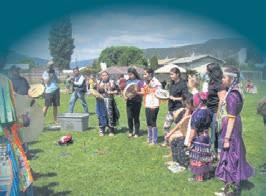
































Young dancers from Lower Nicola Indian Band, N’kwala, and Coldwater schools gathered at the Shulus Arbour on June 6 for the Lower Nicola Indian Band Head Start Children’s Powwow, celebrating culture, tradition, and community.









For the Nlaka’pamux people, bear dancing is a tradition of healing, bestowing blessings of protection on people. For the dancers themselves, wearing the bear skin pelt has set them on a journey of healing. Brothers Robert Narcisse and John Tom are some of Merritt’s few bear dancers.
The two have been practicing the historic tradition for a while, with Tom having danced for two years and his older brother for 10.
The brothers appear in events around the Nicola Valley, such as Canada Day or Indigenous People’s day, practicing prayers and spreading healing to the onlooking
WEIGHT: continued on page 21































WEIGHT: continued from page 20
are carefully rehearsed, and the pelts from real bears that they carry on their backs and heads while doing so are heavy. All of this makes becoming a bear dancer a physically taxing endeavor.
“You got to be in pretty good shape,” Tom said, who carries the lighter of the brothers’ pelts. “It took me a little bit of time for me to start dancing. I had to get used to the steps and how heavy the bear is.”
The weight of a grizzly bear pelt can weigh around 50lbs to 100lbs.
While bear dancing requires a healthy lifestyle, Tom and Narcisse didn’t always live like that. The brothers both got into bear dancing as a way of practicing sobriety.
Before Tom had been initiated as a bear dancer, his brother had already been practicing the tradition for years.
Narcisse had wanted to initiate his younger brother into becoming a bear dancer, and talked to him about it slowly over the course of a few years as Tom was getting sober.
Narcisse had gone through a similar

RAMEnviroGroup honourstherichhistories, cultures,andcontributionsofIndigenousPeoples. Today,andever yday, westandinrespect, recognition,andsuppor tof Indigenouscommunities.
225LougheedRd Kelowna,BCV1V2M1 info@ramresponse.ca 778-900-4564 24hrEmergencyline:(855)237-9163


journey himself. He went sober for five years before becoming a bear dancer.
“I was initiated by my brother here. He brought me in and told me all about bear dancing and how you got to be living a sober lifestyle to be a bear dancer,” Tom said.
While sobriety can be a hard battle for some, Tom said he had bear dancing to keep him disciplined.
“I was looking for something more to help me be strong in my sobriety. And this is one of the main things, becoming a bear dancer,” he said. “You gotta be living your life in a good way.”
The meaning of the bear traces back to ancient customs. The Nlaka’pamux have always thought of the bear as a teacher, showing people how to take care of themselves and even take care of others, like children.
As the brothers perform and practice their prayers, Narcisse said they are channeling energy from the Creator to heal people and provide protection.
“It’s not us doing the healing at all, we’re just the vehicle for it all to pass through,”
INSPIRING: continued on page 22

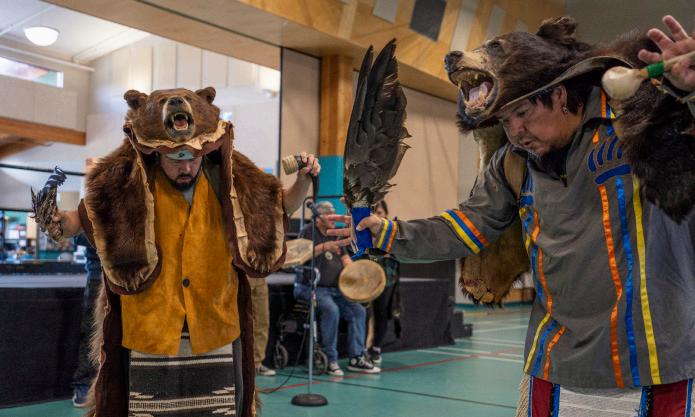
INSPIRING: continued from page 21
Narcisse said. “We put up our paws and that’s sending out good energy and a blessing. And it doesn’t come from us. That comes from the Creator and goes through our bear.”
He also said at the same time, they also have a rattler with eagle feathers inside. They would shake the rattler with good intentions and sweep it towards people as a gesture of cleansing.
He said that some people need extra healing and protection. For that, they have a special procedure.
“They’ll go into the centre, and me and brother will dance around them, probably up to four times. And then we’ll brush them down with our eagle fans and shake our rattles and get everything that’s negative or anything that’s hurting them, off of them, pulling it down. And then when
we’re done that, then we’ll pull up from Mother Earth and fill them back up.”
The brothers had recently performed at the Lower Nicola Indian Band School in May where they taught kids about the practice of bear dancing and how it promotes clean living.
Narcisse said he was happy to see that some of the kids wanted to become bear dancers after their presentation.
“Our next generations are interested in bear dancing as well, and they know that you gotta live a clean lifestyle to do this kind of work. And that’s what we’re aiming to do, is inspire healing, sobriety and culture,” he said.
“I thought that was a really beautiful thing.”
TY LIM reporter@merrittherald.com
Editor’s note: This article uses interviews from sources talked to in a past edition, April 10, of the Merritt Herald on the same subject matter.
The languages of the Nlaka’pamux and Sylix people are holding onto a lifeline. Many of the remaining fluent speakers are looking onto the young generations to keep

the languages alive.
Friday, June 13 was a historic day for speakers of Indigenous languages, and especially to the speakers of the regional dialect, Nlaka’pamuxcin. On that day, graduates from Nicola Valley Institute of Technology (NVIT) celebrated the completion of their education, 35 students learning four Interior Salish languages
HISTORY: continued on page 23





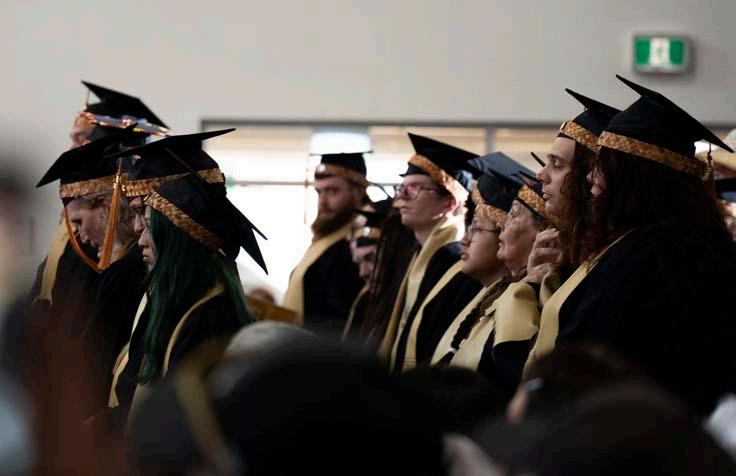
HISTORY: continued from page 22
receives their degrees, diplomas and certificates in front of an audience of hundreds of people which included the president of NVIT, the chiefs of some of the five local native bands and the mayor of Merritt.
Of those graduates, five held a particular importance to the survival of N’laka’pamuxcin language. The five graduates; Leo Charlie, Andrew Dexel, Shenandoah Sunshine Shuta O’Donovan, William Sandy and Sondra Tom received their bachelor degrees in Nlaka’pamux language fluency, a four-year program offered in part at NVIT and to be completed at UBC Okanagan.
Their graduation marked a “true moment in history” according to one Nlaka’pamux language learner Jamie Swakum, who had earned her diploma in the fluency of the language that Friday as well.
Before the ceremony had even started, NVIT President and member of the Upper Nicola Indian Band John Chenoweth took to the stage saying a few words about the language fluency programs.
“We are in a crisis moment,” he said, mentioning that many of those fluent in Interior Salish languages are getting older and the time for young people to learn is getting smaller.
He said NVIT tries to promote talking to Elders and learning from them so their traditions are passed on.
“As an institution, it’s our responsibility to be the school that asks our Elders about those stories; the language, the land and

their ways,” Chenoweth said.
For many of the graduates, they had to learn the language in order for it to survive, seeing the lack of speakers in their own community.
Previously, Nlaka’pamux language fluency diploma student Tsatu Bobb, a member of Spuzzem First Nation, said there was only a single fluent speaker remaining in her community.
The decline in speakers mainly rests in cultural assimilation policies that residential schools enforced.
The Canadian government, recognizes its past role the creation of the Indian Act and residential schools across the country and their impact on Indigenous culture across the country.
“My great grandmother was very fluent (in Nlaka’pamuxcin),” Bobb said. “But she was ashamed because of the forced assimilation and colonization of Spuzzum First Nation during the gold rush.”
“Whenever the priests were around, she wouldn’t speak.”
James Shuter - or Cicums in Nlakapamux - is language teacher at Lower Nicola Indian Band School and residential school survivor, spent much of his childhood in residential school in Lytton. The place was called St. George’s School.
Despite efforts, that he recounted of residential schools trying to remove Indigenous children from their culture
- The National Centre for Truth and Reconciliation states a former employee of St. George’s School was found guilty of
ALIVE: continued on page 24






ALIVE: continued from page 23
numerous sexual harassment cases
- Shuter (Cicums) remains fluent in Nlaka’pamuxcin.
He said he remains fluent due to efforts from himself, trying to learn as much of the language as he could from older children in residential school with him.
When Shuter (Cicums) became an adult, his knowledge of the language would increase as he and his friends would gather, speaking Nlaka’pamuxin in short sentences.
“A lot of the big, long sentences, we kind of forgot because we didn’t hear them that often,” he said.
Shuter (Cicums) worries about the state of the language, as there isn’t much of an official place for only that language to be spoken. He said even Elders switch back and forth between their language and English.
Desiree Marie Collins is a Nlaka’pamux language fluency certificate student and a member of the Coldwater Indian Band. She had also walked across the graduation stage last Friday. She said she is one of the younger generations of learners who are eager to revitalize their language.
“I haven’t seen a lot of language revitalization lately (in her community), so I’m just


trying to take those next steps and teach my son the language.”
Collins works with Citwx Nlaka’pamux Assembly as Nlaka’pamuxcin research support, where she said she is able to put her language lessons to use.
“I’m learning a lot,” she said. “Any (Nlaka’pamux) posters at CNA, I’m probably attached to that.”
Collins said she also helps the Elders in her community, socially interacting with them. She said learning the language has allowed her to say a few words back and forth with them.
Collins said there are more members of the Coldwater Indian Band who are taking the language fluency program but have not yet graduated.
She said she might continue her education to get a bachelor degree in Nlaka’pamux Language Fluency.
Andrew Dexel is a language learner that can attest to the amount of work it takes to become fluent in Nlaka’pamuxcin. He is a member of Nooaitch Indian Band and he took the four year journey to gain his bachelor’s degree.
“There’s (still) lots to learn,” Dexel said after graduating. “They say for a
FLUENCY: continued on page 25













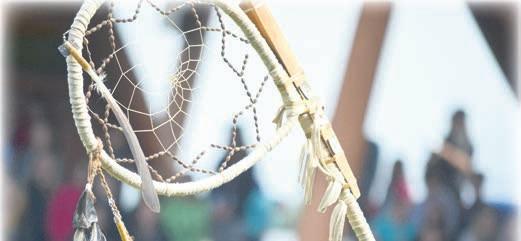



































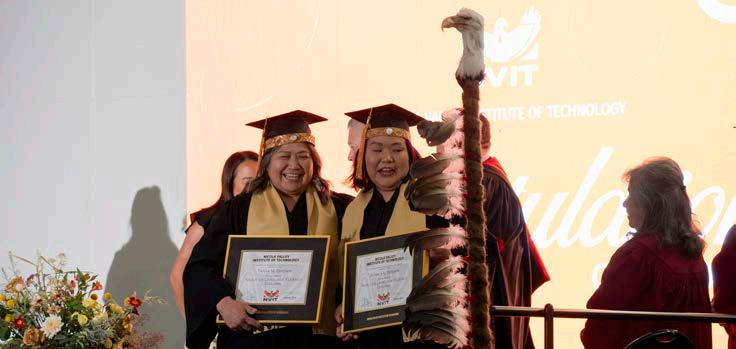
polysynthetic language (like Nlaka’pamuxcin) it takes up to 4,000 hours. I’m about a thousand hours in, so I have a lot of work left to do.”
“My main goal is to create those opportunities to continue to learn and become fluent and bring along as many people as possible.”
Dexel said he wants to pass down the language to his son and to create more “points-of-contact” to make it easier for people to learn in the future.
“We want our children to have something
good,” he said. “Within our language there’s so much information about who we are and what our worldview is. It’s important for us to have that so we can continue on with our identity and continue on with our unique traits and qualities about our people and how we’ve survived for thousands of years. And we need that now more than ever.”
He said graduating is just a start, and he’s looking forward to seeing how learners can come together and create a community, making it easier for people to learn.
























TY LIM reporter@merrittherald.com
Generations of Indigenous and non-Indigenous fishermen are looking into the Nicola Valley rivers and asking, ‘where did the salmon go?’
It’s no secret that salmon are struggling around the world. A recent study published in May by Concordia University in Quebec says the number of salmon have declined by 80 per cent since 1980.
Last September, the Pacific Salmon Foundation released their 2024 State of Salmon report which said 70 per cent of salmon in B.C. and the Yukon are suffering from long-term population declines.
The effect is being seen in the Pacific oceans, where fishermen are catching less salmon than they were 20 years ago.
Statistics from Watershed Watch, a non-profit looking out for the health of wild salmon, say that salmon catch numbers are a fraction of what they were 40 years ago or 10 salmon cycles. In 2024 there were under five million catches from across B.C. compared to 1984 where there were almost 20 million.
The Pacific Salmon Foundation states that current salmon stocks are facing “unprecedented pressure” due to climate change and 150 years of industrial development.
In 2021, the Narwhal reported that First Nations in Northern B.C. (In Bella Bella) were recording record low salmon returns. While Merritt and the other communities
were not founded as and are not communities that rely on fish, salmon remains an important part of the area’s ecosystem and culture, especially to the area’s First Peoples.
B.C.’s Interior, including the Nicola Valley, is home to many salmon spawning grounds. Salmon from here travel all the way down to the Fraser River, then out to the Pacific Ocean reaching even to the Bering Straight before trying to find their way back to their spawning ground, completing their four-year cycle.
Experts interviewed later in this article say that the decline in salmon is not an issue that can be solved at a local level, due to the vast and complex travel patterns of the fish. Still, as an important step in the salmon’s life, they say there are steps the area can take to make a healthier habitat for salmon.
For Elders within Nicola Valley First Nations, the decline of salmon is one they’ve been seeing for years.
Carl McLeod, is a member of the Upper Nicola Indian Band. He is one of the people that have been wondering where the salmon have gone.
“All our Elders are really crying about it,” he said.
McLeod has been following the issue for years. He is also an advocate for the health of the local watershed. Over the years he has seen the number of fish be in decline.
“For the past four years, we didn’t have no
























LOSS: continued from page 26
sockeye (salmon). Sockeye is one of our most traditional foods, and we haven’t had none of that come back up this river,” he said.
He says a majority of the issue is sport fishermen and large fishing companies overfishing. He is advocating for more cooperation between government, sport fishermen and first nations into all protecting the salmon.
“We’re going to be fighting, just like we’re doing with the salmon,” he said.
Salmon and the Indigenous people of the Nicola Valley have a long history. For some, salmon decline represents a loss of culture.
For Arnie Narcisse, who lives in Lower Nicola, his family has historically relied on wild salmon to survive, catching and preparing the fish themselves.
Today, he said around half of his diet probably revolves around salmon.
“Since the beginning of time, we’ve had a symbiotic relationship with these creatures we call (salmon). We celebrate that relationship with songs and stories and dances,” Narcisse said.

“If we were to lose the salmon, we would lose all of that and that would be the saddest thing that would ever happen, is that a whole world of knowledge would just simply disappear.”
When Narcisse was a child he was forced into residential school. One of the last photographs taken of him before he was taken to residential school was of him fishing for salmon with his mother.
Narcisse remembers the moment as his “last moment of freedom”. To him, it also represents the last of the traditional knowledge of fishing he was able to hang on to through years of residential school teachings. He described his fishing knowledge as “holding onto a handful of sand”.
Narcisse devoted his whole adult life to the practice of fisheries and the upholding of traditional fishing laws.
He climbed high in the world of fisheries, meeting regularly with representatives from Fisheries and Oceans Canada and the Canadian government and high profile environmentalists such as David Suzuki. He was at one point the head of the
CRISIS: continued on page 28






CRISIS: continued from page 27
Aboriginal Fishing Commission.
Narcisse has tracked and has tried to prevent the decline in fish forever. The people around him were seeing it too.
Narcisse said the fish decline began in the early 1910s, when railroads were being built across the Interior. He said his grandfather - the man who taught Narcisse about Indigenous fishing practices - even saw the decline of salmon during that era.
“Gold mining was just literally destroying habitat everywhere, the sedimentation that came from the gold mining practices, just crap coming off there and going into the river. So the fish had no place to spawn,” Narcisse said.
Narcisse spent a lot of his life heading restoration projects in the Coldwater River. During the 1990s, Narcisse and his team were able to build a few projects that temporarily increased the abundance of fish.
“We do habitat creation, habitat creation, side channel areas, bank stabilization, basically anything and everything to give them a fighting chance,” he said. He said were highly successful in returning fish over a four-year cycle. Programs like these were short-lived through the 90s, as Narcisse said Stephen Harper’s Bill C-45 passed in 2012, which provided changes to the Fisheries Act which provided more loose guidelines for any harm done to fish habitats.
“All the environmental protection measures and everything that went along with that, the funding for these types of (environmental protection) activities went out the door as well,” Narcisse said. He is worried about the next 20 years, hoping the increase in farmed fish doesn’t completely kill the practice of having wild salmon.
Richard Bailey is a former fish biologist with the department of fisheries, living in Kamloops. He is saying that the success of salmon is fluctuating depending on the species. He used Coho fish as an example of a fish that is doing well.
“We’re releasing more hatchery coho into the Coldwater River than we ever have,” he said.
He said overfishing is not as much of an issue as it was 40 years ago in the 1980s. He said that during that time, 75 per cent of released coho were being caught in open ocean. Today, that number is around 10 per cent due to stricter fishing laws. Still, fish aren’t surviving to return as adults. Bailey said that coho from Capilano
hatchery had about a 25 per cent return rate as adults in the 1970s. Today, he said that number is at two per cent.
According to Bailey, there isn’t just one cause of the salmon crisis.
One of the issues is that there’s an overabundance of fish in the open ocean. The northern stretch Pacific Ocean is somewhat of a gathering ground for Salmon from Canada, Alaska, Russia and Japan.
Fish from all over the world come there to sustain themselves on that region’s finite aquaculture.
“A big part of the problem is that in the North Pacific, off the Aleutians, there are more salmon now than there ever have been in history,” Bailey said.
He said places - such as Russia, Japan and Alaska - are rapidly releasing chum and pink salmon into the ocean, where they can eat the resources out there, then return to those places where they can be fished.
“It’s a hatchery program to basically create a commercial fishery at home, but they’re chewing up the resources in the high seas,” he said. “So we have a significant problem in the high seas.”
“(Our salmon) They’re coming back younger because they don’t survive as long in the ocean, the ones that stay out longer aren’t surviving because there’s no food. We’re seeing a loss of productivity of sockeye. We’re seeing a loss of productivity of Chinook, basically, because the ocean out there is so full of fish that never used to be there.”
Locally, fish are struggling with climate change and the effects of long-term industrialization. For one, Bailey said the Strait of Georgia is changing because of climate change.
Bailey said the local rivers and watersheds have been drastically impacted by climate change.
“We have profoundly changed the watershed as a result of logging, fires and pine beetles, and it’s going to take a long time to get that watershed back to healthy, and there are profound challenges involved with that,” he said.
Bailey said everything we do impacts salmon habitat.
“Salmon habitat starts at the mountain top and it ends at the lake bottom, because everything that happens at the mountain top still influences the flow in the river. How fast does the snow melt? Is there water there that’s going to contribute at
















REPOPULATION: continued from page 28
the right time of year to the river right when it goes into the ground? All of these things are critically important to understanding how salmon tick.”
He also recognizes how this might poses a dilemma for communities who have to balance long-term environment sustainability with economic income.
Resources like lumber and water are not only necessary to harvest in order to grow a population, but also to put on the market to increase a town’s economic standing.
“We have to understand that large numbers of people and healthy salmon populations do not get on very well,” he said. “People still want to have an income from forestry, but honestly, that’s counterproductive right now to getting the watershed back to healthy.”
“There is a problem that we have to face up to, and that is that we are out of valleys that we can go over the hilltop and go we’re going to log it, burn it, pave it, and then move on to the next one. And when we finished, we might as well mine it as well.Those aren’t renewable resources.”
These measures have essentially harmed the salmon population little by little creating a “death-by-a-thousand-cuts” scenario.
HOPE FOR REPOPULATION?
While much of the decline in salmon is due to international policy Canadians cannot directly control, Bailey said we can still address smaller pieces of the puzzle.
“It’s really important that habitat in the lower Fraser is rehabilitated, and habitat in the Thompson’s rehabilitated on all of this






will contribute (to healthier salmon population),” he said.
He said there is currently a partnership in the Nicola Valley that could be vital to restoring local salmon populations. The partnership is called the Salmon Ecosystem Table, and is holds members of the federal and provincial government as well as the chiefs of the five Nicola Valley Indian Bands. According to Bailey, the agreements that come out of this committee are the best chance the river has of rebuilding.
“One of the most important things that can come out of this, quite honestly, is the legal like legally binding landscape planning agreement that the chiefs have with the Province around the water governance, and that is, in my mind, the long term hope for rebuilding salmon,” he said.
“If the chiefs draw a line in the sand and say, this is what this landscape is going to look like, that gives us the very best chance under the right landscape to rehabilitate the river system. And without a rehabilitated river system, all you can have is hatchery produced fish.”
He said that there will be complications with rebuilding the watersheds. This includes adapting to ecosystems to function in spite of climate change.
Bailey said many of the efforts we can make right now are only “triage” efforts that will keep the river alive. He said if we are doing good in 30 to 40 years, then we can make major efforts to rehabilitate the river.











































































































































LAÍSA CONDÉ editor@merrittherald.com
Indigenous graduates at NicolaSimilkameen School District (SD58) have tossed their hats this past week to close the chapter of their high school lives.
Sixty four Indigenous students alongside with their families, friends, school district representatives gathered at the Nicola Valley Memorial Arena to celebrate this milestone in their lives.
Courtney Lawrance, superintendent at SD58, highlighted the students’ accomplishment and the new chapter in their lives.
“Today is one of life’s important rites of passage that is attested to the strength of the love and support that is surrounding these graduates,” she said. “Indigenous graduation holds a special place in my
heart as it truly embodies the journey towards meaningful truth and reconciliation.”
She highlighted that her work centered on increasing Indigenous graduation rates, which in early 2000s were as low as 33 per cent in some provinces.
“Today illustrates how far north can come in ensuring that Indigenous leaders have access to multiple pathways and options as they enter post secondary, trades school or the world of work,” Lawrence added.
“Indigenous graduation ultimately proves the research is correct. That positive relationships, meaningful inclusion of language and culture and connection increases life chances and opportunities for Indigenous learners.”














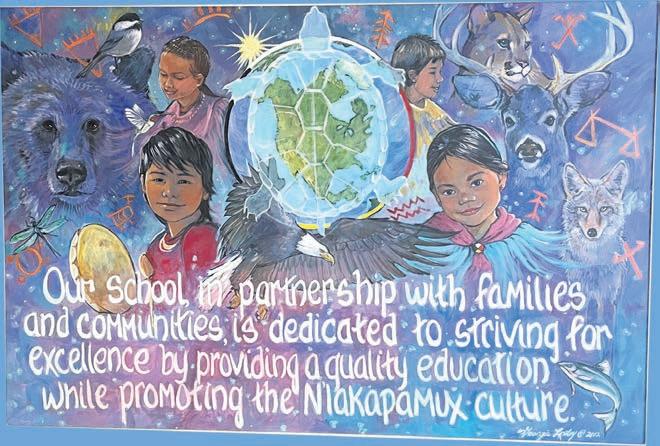
•Mustbe 5yrsbyDec31,2025
•BusServicesProvidedto most areasofr itt f Merrit
CURRICULUM:
•BcEducationCurriculum
•TwoRecessesPlusA Lunch
•Nle?Kepmxcin(K-7)
•CulturalStudies
•LearningAssistanceProgram
•SchoolSuppliesProvided
•Skate/HockeyProgram
•ScienceofReading
FACILITIES:
•Full-SizeGymnasium
•ClassroomLibraries
•A CalmingSpace
•Baseball/SoccerField
PLAYGROUNDEQUIPMENT
•ClimbingWall
•BasketballCourt
•Spinner WE HAVE MONTHLYFAM ILYD INNE RS ANDE LDERSLUNCHEONS
•Literacy& NumeracyBlitzesAfterLunchEveryDay
•WeParticipateInTheDistrictElementarySportsProgram
•WeAreOnTheLandForFieldTripsOften
•WeAreA PlayIsTheWaySchool
LOWERNICOLABANDSCHOOL -EDUCATIONCOMESFIRST
Phone: 250-378-5527
•www.lnib.net/band-school/• 201HornRd.,Merritt,BC

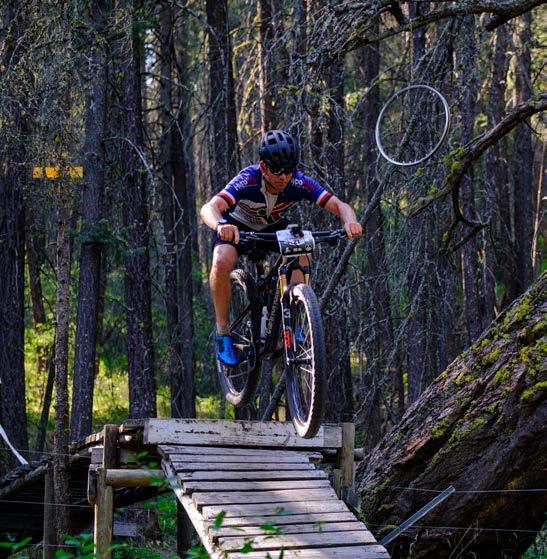



















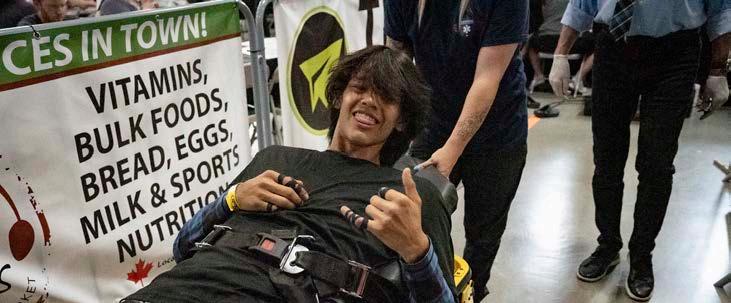




PHOTOS: CASH
Top: Ty Lim (pink) and Riki Baron (white) in a boxing exchange.
Middle-top: Grappler Kasey Wycotte after popping his knee.
Middle-bottom: Lim’s opponent, Riki Baron getting the decision win. Lim during a medical check-up after fight.
Bottom: Wycotte in guard.










Crossroads Community Church
2990 Voght St. • 250-378-2911
Service Time: Sundays 10:00 a.m.
Merritt Baptist Church
2499 Coutlee Avenue (at Orme) Sunday service 10 am, Phone (250)378-2464
Merritt Lutheran Fellowship in St. Michael's Anglican Hall • 250-378-9899
Service Time: 3rd Sunday each month 1:30 p.m.
Sacred Heart Catholic Church Corner of Jackson & Blair • 250-378-2919
Mass Time: Sundays 9:00 a.m.
St. Michael’s Anglican Church
1990 Chapman St. • 250-378-3772
Service Times: 2nd and 4th Sundays only - 10:00 a.m.
Trinity United Church Corner of Quilchena & Chapman • 250-378-5735
Service Time every Sunday - 10 am
Somang Mission Community Church (SMC) 1755 Coldwater Ave. (The Cadet Hall) Sunday Service Time: 4:00 pm • 250-280-1268
Nicola Valley Evangelical Free Church 1950 Maxwell St. • 250-378-9502
Service Times: Sunday 10 am
Deadline for placing a classified ad is 5 p.m. on Monday. To place an ad please call 250-378-4241 or email: publisher@merrittherald.com


Michael(Mike)Gerard WilliamGuichon
December26,1982 -June10,2025
Itiswithheavyheartsthatweannouncethe passingofMichael(Mike)Gerard William GuichononJune10,2025.
www.merrittherald.com

There is much talk these daysabout ‘closure’. Saying good-byetosomeone welove, even after theyhavedied, doesn’t require that weput an end tothe relationship
www.merritthospice.org
Email:merritthospice@shaw.ca MERRITT &DISTRICT HOSPICE SOCIETY
MikewillbesadlymissedbyhisMother,JudyGuichonandherhusband BrunoMailloux;hissisterAllisonCrawfordandherchildrenTaylor, Dannyand Ronnie;hissisterTabithaGuichonandherdaughterJordyn;hisbrotherDarcy Guichonandmanyfriendsandrelatives.Hewaspredeceasedbyhisfather, LaurieGuichon.
Mikelovedspendinghistimeoutonthewater.Whetherthatwasfishingin theoceanorboatingonthelake.Hewasalwayslookingforwardtohisnext adventureandhisnextbigcatch.

HOURS: FullTime–35hrs/wk
SEPT 4, 1929 to JUNE 12, 2025
It is with great sadness the family of Ralph Thomas Thomsen announces his passing on June 12, 2025 in Edmonton at the age of 95.
Ralph spent his life doing what he loved most, ranching. Cattle and horses were his life work and his passion. He ranched on the family farm in Vermilion AB, until 1981 when he and his wife Irene bought a ranch in Merritt, BC. It has been only the past few months that Ralph moved to Edmonton with his family.
DESCRPTION: ReportingtotheSocialDevelopmentCoordinator,theCommunityConnections Navigatorwillberesponsibleforhelpingcommunitymembersnavigatechallengeswhile supportingthewellbeingofindividualsandfamiliesinaholisticmanner.TheCommunity ConnectionsYouthNavigatormustuseacollaborativeapproachwitheachcommunitymember tosupporteachpersoninachievingtheirgoals.
Ralph is survived by his six daughters Linda (Len), Audrey, Carol, Arlene, Janice (Cal)), Gail (Mark)
Grandchildren Jesse, Alicia (Jevere) Melanie, Melissa, Courtney (Dan), Nicole (Rob), Chris (Laceigh), Natasha, Dustin (Heather)
Great grandchildren Christy, Zoe, Shaylyn, Keagan, Colton, Kitsune, Damyan, Kylo, Octavia, Heyden , Jaxton, Zaiden, Quila, Kyra, Cole, Havyn, Hudson, Cruz, Jax, Finn, Nash, Palmer, Caden, Conor, Hannah, Josie, Eloise as well as numerous great great grandchildren. Ralph also leaves to mourn his passing his sister Hazel.






SpecificDutiesandResponsibilities: PerformsalldutiesandresponsibilitiesinaccordancewiththeColdwaterIndianBand policies,standards,andprocedures,andasdirectedbytheFinanceCoordinator.Maintains confidentialityinallmatterstotheaffairsoftheColdwaterIndianBand. 1.Provideinformationandlinkagetoappropriatecommunityservices; 2.Guideandmotivateduringimportantperiodsofdevelopmentintheirwellnessjourney; 3.AcceptreferralsfromCommunity,SocialWorkers,othercommunityservicesandetc.; 4.Outreachandengagementinthewiththecommunity; 5.Developandmaintainparticipantdrivenintegratedwellnessplans; 6.Advocateforparticipants’needs; 7.Supportparticipantstobuildcapacityinareassuchascommunication, self-advocacy andrelationships; 8.Participatewithteaminprovidingdeliverableactivitiesorinformation. 9.Participateinteammeetings; 10.Maintainaccuraterecords; 11.Otherrelateddutiesasassigned.
RequirementofCommunityConnectionsNavigator
Ralph is predeceased by Irene his wife of 64 years , his father Chris, his granddaughter Christina, his grandson Shawn, his great grandson Christopher, his son-in-laws David and Frank and his sisters Ruby and Doris.
Ralph’s family and many friends will miss his great stories of life back in the good ole days when work was much harder but a simpler life.
•DiplomaorDegreeinSocialWork(otherrelatedfieldswillbeconsidered); •ExperienceworkingwithFirstNationsCommunity; •AccesstoreliablevehicleandcurrentDriver’slicense; •PassableCriminalRecordCheckandDriver’sAbstract; •Ableandwillingtoworksomeeveningsandweekends.
Deadlineforsubmissions:January26th,2024
A celebration of Ralph’s life will be held on July 12th 11:00 am at Pozzobon Ranch, Merritt, B.C.
Onlythoseapplicantsselectedforaninterviewwillbecontacted.
PleaseforwardResumeandCoverLetterto: CynthiaL.Jager,SocialDevelopmentCoordinator,cynthia@coldwaterband.org POBox4600,Merritt,BC,V1K1B8


September17,1947 ~June5,2025



JudyFavellediedpeacefullyonJune5,2025, surroundedbyfamily,afterlivingformanyyearswitha numberofsignificanthealthchallenges.She was77.


DESCRIPTION: ReportingtoSocialDevelopmentCoordinator,theHomemakerisresponsiblefor providinghomemakingservicestoclients.
SPECIFICDUTIESANDRESPONSIBILITIES:
Homemakingincludes:
A18 THURSDAY, January 4, 2024
Judy wasborninNewWestminsterinSeptember1947andspenther earlychildhoodinseveralsmallVancouverIslandcommunitiesbeforeher familysettledinMerrittin1960.She wasathleticandenergeticinher youngeryears—knownforherspeedandstrength—and wasahighschool heerleader.Inherteenyears,shelivedfor atimewithheraunt anduncleinNanaimo.Aftergraduating,shebeganworkingattheBankof Montreal,markingthestartofalongandsteadycareerinbanking.
•Generalcleaningandorganizationofrooms,laundr y, disposingofgarbage;
www.merrittherald.com

•Schedulingandprovidingtransportationforerrands;
•Monitoringofmembershealthandmedications,providinggrocery lists,andpreparationoffood whennecessary
Thompson-NicolaRegionalDistrict
TheHomemakermaintainsdailyrecordsofservice,informsSocialDevelopmentCoordinatorof clientemergenciesandfollowsaschedule.
RequirementsofHomemaker Position:
When? Thursday,January18th,2024,at1:30PM

•Accesstoreliablevehicleandcurrentdriver’slicense
TheBoardofDirectorsoftheThompson-NicolaRegionalDistrictgivesnoticethatitwillholdaPublicHearing intheTNRDBoardroom,4thFloor-465VictoriaStreet,Kamloops,BC,toconsiderproposedBylaw2822. WhatisTemporaryUsePermitTUP68,Bylaw2822,2023?
Itwouldenable Traveller
ShemetJackFavelleat adanceinMerritt,andtheyquicklydiscovered asharedlove ofmusicandmovementthat wouldshapemuchoftheirlife together.Theymarriedin1967andwelcomedtheirdaughter,Tracey, in 1970.From1978to2010,JudyandJacklivedinKamloops,whereJudy workedattheRoyalBankofCanadafor over30years.Sheplayedsoftball, bowledinlocalleagues,golfedregularly women’sgolfleagueformanyy andspentmanyweekendscampingwit
AccommodationUse (“short-term rental”)withinanexistingsingle-family dwellingat6592MonckParkRd,at NicolaLake(PID:026-485-541), shownshadedontheadjacentmap, zoned LR-1:LakeshoreResidential zoneforuptothreeyears.The specificTUPconditionsarestipulated ontheproposedpermitwhichforms partofBylaw2822.
Afterretiring,theymovedtoPentictonandsettleddirectlyint buildingwhereJudy’sfatherAlecli ofcarefollowingtheearlierlossofhermother bowlinginPentictonleaguesandremainedacti relationships that gave herlifestruct includinga specialtriptoMexicowithhersister-in-lawBrendaandniece Nicola,andsheandJackcontinuedto exploretheOkanaganandbeyond intheir RV
•CriminalRecordChecks
LandAct:NoticeofApplicationforaDispositionofCrownLand
•Experienceworkingwith FirstNationCommunity
•Grade12Educationpreferredwith FoodSafe/WCB FirstAidLevel1

•UptodateonImmunizations&TBtest
•HomeCareAttendantCertificatewouldbeanasset(differentthanResidentCareAidCertificate)
25Hour Work Week
Allpersonswhobelievethattheir interestinpropertymaybeaffectedby theproposedbylawshallbeafforded areasonableopportunitytoprovide inputatthePublicHearing.AnyonewhowishestopresentattheHearingvirtually(viaZoom)mustcontact LegislativeServicespriortonoononJanuary16th,2024,toarrangevirtualaccess.Anyonemayalsomake writtensubmissionsonthematterofBylaw2822(viatheoptionsbelow),whichmustbereceivedatouroffice priortonoononJanuary16th,2024.Theentirecontentofallsubmissionswillbemadepublicandformpart ofthepublicrecordforthismatter.
HowdoIgetmoreinformation?
TakenoticethatWaterBoyTruckingLtd.fromMerrittBChasapplied totheBritishColumbiaMinistryofForests(FOR),Thompson-OkanaganforanexpansionofanexistingrockquarrysituatedonProvincial CrownLandlocatedoverunsurveyedCrownlandbetweenDistrict Lots4426and4427,KamloopsDivisionYaleDistrict(KDYD). FORinvitescommentsonthisapplication.TheLandsfileisFile Number3410347.Writtencommentsconcerningthisapplication shouldbedirectedtotheSeniorLandOfficer,ThompsonOkanagan, FORat441ColumbiaStreet,KamloopsBCV2C2T3.Commentswill bereceivedbyFORuptoFebruary26,2024.FORmaynotbeable toconsidercommentsreceivedafterthisdate.PleasevisittheApplications,CommentsandReasonsforDecisionDatabasewebsiteat http://comment.nrs.gov.bc.ca/ formoreinformation.
Pleasesendresumeto:emailfcwn@coldwaterband.orgattention: TaniaStewart PursuanttoSection41oftheBCHumanRightsCode,preferencemay begiventoqualifiedapplicantsofIndigenousancestry.
Beadvisedthatanyresponsetothisadvertisementwillbeconsideredpartofthepublicrecord.Accesstotheserecordsrequiresthe submissionofaFreedomofInformation(FOI)request.Visit http:// www.gov.bc.ca/freedomofinformation tolearnmoreaboutFOI submissions.
Judy wassteady,loyal,anddedicatedtothepeoplesheloved.Sheshowed upforher family—drivinglongdistancestobeathergrandchildren’s volleyball games,musicrecitals,graduations,holidays,andweddings.She didn’tdrawattentiontoit,butshe wasthere.Andherpresencemattered.
CopiesoftheproposedBylawandallsupportinginformationcanbeinspectedfrom8:30a.m.to4:30p.m., Monday-Friday(exceptstatutoryholidays)atouroffice,fromDecember22nd,2023,until1:30p.m.onthe dayoftheHearing;orpleasecontactusviaanyoftheoptionsbelow.
Forinfo&submissions
Mail Phone Email Website
Shehadlongstandingfriendships—somelastingmorethansixtyyears— and awayofmakingpeoplefeelwelcomeandatease.Herhumour was oftendry,andwhensomethingtrulystruckherfunnybone,herlaugh— punctuatedby asignaturesnort—couldsetoff arippleoflaughterinthose aroundher.

#300-465VictoriaSt Kamloops,BC V2C2A9 (250)377-8673 1(877)377-8673 legservices@tnrd.ca www.tnrd.ca
NorepresentationswillbereceivedbytheBoardofDirectorsafterthePublicHearinghasbeenconcluded. A.Krause,GeneralManagerofDevelopmentServices


Judyalso facedsignificanthealthchallenges overtheyears.She wa iagnosedwithlymphomain1996,underwentsurgeryfor alarge meningiom 018thatleftlastingcognit ndphysicaleffects,later facedbreastcancer,aseriouscaseofCOVID,and areturnoflymphoma inherfinalyears.Thesechallengestestedher,butshemetthemwithquiet resolve.

Judyissurvivedbyherhusbandof58years,Jack;theirdaughter Tracey andson-in-law Ryan;fourgrandchildren,Isaiah(Julia), Lydia,Matthias (Reagan)andGabriel;andthreegreat-grandchildren.Shealsoleavesher brotherBrent,hiswifeBrenda,andtheirdaughterNicola,alongwith extended familyandfriendsfrommany stagesofherlife.
Takeourquickandeasyquestionnaireto helpusunderstandriskfactorsand improvescreeningmethods.
She waspredeceasedbyherparents,AlecandJessieCampbell nd remainedcloselyconnectedtothemthroughoutherlife.
Hermemorylivesoninthesmallroutines,sharedstories,andgestures ofcareshequietlyofferedtoothers.


Youmustbe: www.uterinehealth.ca/research-projects/restore

Thefamily extendsheartfeltthankstothestaffandvolunteersat LangleyHospiceResidencefortheirexceptionalcareand compassionduring Judy’sfinaldays.
postmenopausal atleast3yearspastyourlastperiod notreceivinganyhormonetreatment stillhaveauterus(nohysterectomy)














Thursday,June26,at1:30PM
TheBoard ofDirectorsof the Thompson-Nicola RegionalDistrict gives notice thatitwillholda PublicHearing inthe TNRDBoardroom,4th Floor - 465 Victoria Street,Kamloops,BC,toconsiderproposedBylaw2879, 2025.
WhatisproposedBylaw2879,2025?
Itsets out numerous “housekeeping” changes toTNRD Zoning Bylaw 2400, including:
• Removereferenceto ‘aircraft landingfield’inthe AF-1 & RL-1zones(Federaljurisdictionsupersedes localzoning);
• Update s. 4.3.7 regarding RAPR(Riparian AreasProtectionRegulation)toalignwithcurrent Provincialrequirements;
• Expandhousing types which permit‘bed&breakfast’usetoinclude duplexand manufactured home, and clarifyasecondarysuitecannot beusedfora bed & breakfast;
• Define“communityhall”;
• Amendthedefinitionof“dwellingunit”toclarifythattwokitchens canexistin onedwellingunit;
• Amend section 3.7 2tomake it clear that a temporary dwelling for caregivingpurposes(where meetingotherconditions)cancoincidewith onesingle familydwelling (with orwithout a secondary suite),or oneduplex, oronemanufactured home;
• Remove“petbreedingand kennel use” as a permittedaccessory useintheAF-1,AF-2,andRL-1 zones;and
• Amenddefinition of“processingofaggregate materials”tomakeclearthattemporaryproduction of concreteorasphaltispermittedfor no longerthan sixmonthsper yearandutilizingonlymaterial extractedfromthesubjectparcel(s) and area identified withina ProvinciallyapprovedMinesPermit.
Allpersonswho believethat their interest inproperty may beaffectedbythe proposedbylaw shall be afforded a reasonable opportunitytoprovide inputatthe Public Hearing.Anyonewho wishesto present at the Hearing virtually (viaZoom)mustcontactLegislative Servicesprior tonoononJune 24th, 2025,toarrangevirtual access.Anyonemayalsomakewritten submissionsonthe matterofBylaw 2879, 2025(viathe options below),which mustbereceivedat our officeprior tonoononJune24th, 2025.The entirecontentofall submissionswillbe madepublicand form partofthepublicrecordforthismatter.
HowdoIgetmoreinformation?
Copiesofthe proposedBylaw andall supporting informationcan be inspectedfrom8:30 a.m.to4:30 p.m., Monday-Friday(except statutory holidays)atouroffice, fromJune 6th, 2025, until 1:30p.m.onthe dayofthe Hearing;or pleasecontactusviaanyoftheoptionsbelow.
Title of respect
Tax collector
Cool!
Sudoku puzzles are formatted as a 9x9 grid, broken into nine 3x3 boxes. To solve a Sudoku, the numbers 1 through 9 must fill each row, column and box. Each number can appear only once in each row, column and box. You can figure out the order in which the numbers will appear by using the numeric clues already provided in the boxes.
53. Strongly recommends
Hit lightly
Bar bill
Atomic #54 58. Devotes again
Fish sauce 65. French stock market
Things that consist of
elements or parts
Tense 1. Retired game show host Sajak
Equal (prefix)
Israeli city __ Aviv
Loved
A type of analyst
Ad __
Gasteyer and de Armas are two
Ran without moving
Opposite of yes
Diffuse clouds of gas
Mentioning one by one
Alternative form of
13. Instruments used to dilate 15. Freshwater fish 17. Remotely-manned flying objects
18. Doctor of Education
Renews 23. Not the start 24. Pitching stat 27. Small water buffaloes 29. Ceramic jars 32. I (German) 34. Something to toss on a fire
Real estate 50. Boy’s name
Airborne (abbr.)
35. The process of flowing in
A series of acts at a night club
Egg of a louse
Inquire too closely
Travelers 44. Drink
Behave in a way that degrades 47. Electronic music style
Northern Ireland city
Father
Upset 54. Stiff structure resembling a hair
North Atlantic fish
8th month (abbr.) 62. Make an effort
Commercial





